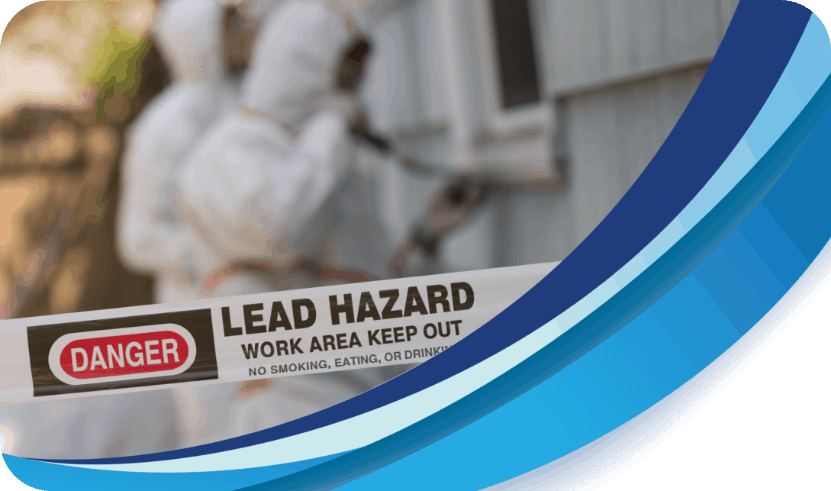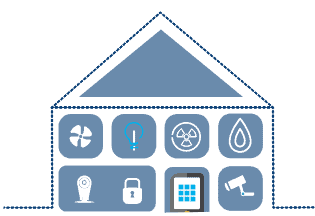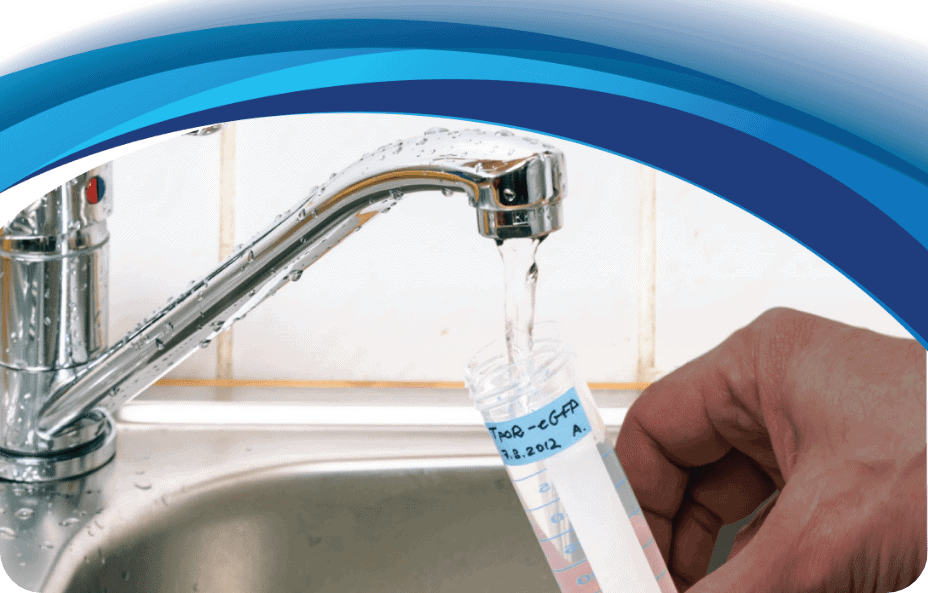You can’t always control what happens outside of your home. Fortunately, there are ways to minimize or eliminate in-home threats such as lead paint, mold, and radon. This guide covers simple, practical, and cost-effective ways to test for air and water quality, asbestos, and more. It also explains how to test your soil.
Table of Contents

- Asbestos
- Lead Paint
- Radon
- Air Quality
- Water Quality
- Testing Outside of Your Home: Lead and Other Contaminants
- Footnotes and References
- Additional Resources
 Asbestos
Asbestos
If your home was built before the 1970s, it may contain materials with asbestos. Fortunately, the risk of exposure is low or even nonexistent as long as the asbestos remains undisturbed and shows no damage. You shouldn’t need testing unless:
- Remodeling or renovation projects are on the horizon
- Materials are damaged, crumbling, or falling apart, as is common with insulation and drywall
People use asbestos in a wide variety of materials such as automotive parts, textiles, insulation, house siding, shingles, and car brakes. When they handle or damage asbestos, its minuscule fibers break apart and can be breathed in. Needless to say, tiny fibers in someone’s lungs is not an optimal setup for good health. The result over time is increased risk of conditions such as lung cancer, asbestosis, and mesothelioma, especially for smokers. The symptoms of exposure may not show up for decades.
Asbestos is a mineral fiber that’s popular because of its heat- and corrosion-resistant properties. It occurs naturally in rocks and soil.
How to DIY: Don’t. Just don’t.
OK, OK, we’ll elaborate. DIY testing kits exist, but most states don’t allow DIY (or self-gathered) samples. If your state does and your heart is set on DIY, follow test kit instructions exactly. No deviations! You can find kits online at retailers such as Amazon. You collect samples and send them in for testing. Do check how many samples your kit covers since it may be just one sample.
People do more harm than good by stirring up materials that potentially contain asbestos. After all, asbestos doesn’t hurt anyone until it is handled or breached. As the EPA says, “leave undamaged asbestos-containing materials alone.” That means no DIY testing, if possible.
The best DIY asbestos prevention is to leave stuff alone and to take appropriate precautions. Suppose you have asbestos popcorn ceilings. It doesn’t take much to release asbestos into the air from these ceilings. For that reason, avoid bunk beds under such ceilings, don’t toss toys or pillows at it, and don’t use screws, nails, or tape.
If material is damaged and could potentially have asbestos, avoid it until you bring in professionals and know more.1 Bring them in sooner rather than later.
- Leave something alone if you have any reason to suspect it could contain asbestos. If you must handle it, like for a home renovation project, call in the professionals.
- Don’t sweep, dust, or vacuum materials that could have asbestos.
- Install new floor coverings over a floor with asbestos when it needs replacing. Avoid leveling or sanding the asbestos floor and its backing.
- Don’t ever attempt to remove asbestos yourself. It increases your family’s exposure to this potentially deadly substance.
Hiring an Expert: You’ll deal with inspectors and possibly contractors (if your house does contain asbestos). Inspectors assess materials, gather and test samples, and discuss corrections with you.
Contractors, also called asbestos abatement companies, repair or remove materials containing asbestos. Inspectors can be involved at this stage too, making sure contractors operate safely and checking the air for any increases in asbestos fibers.
Under federal law, inspectors and contractors do not have to be accredited or specially trained. However, some state or local laws require it. Go with EPA-licensed businesses to be safe.
It’s best to use different companies for inspection and repair/removal. Why? To bypass conflict of interest. A company might be more likely to recommend unnecessary repair or removal if it is also the inspector.
Ask for documentation that the company’s professionals have undergone state or federal training. Check the BBB, your local worker safety agency, and your area air pollution control organization for potential issues with inspectors and assessors.
Inspections should include visual assessments and the gathering and testing of samples. If asbestos is found, inspectors should give you written evaluations of where the asbestos is, the degree of damage, and what the recommendations are for going forward.
Repair involves sealing or covering the material, meaning that the asbestos remains in place. Removal may be necessary during renovations or remodeling projects, or when materials are seriously damaged.
Getting a Lab: The EPA maintains a list of accredited laboratories. Ask inspectors about the labs they use and whether they are EPA-certified.
For DIY kits, lab fees should be included in the sale price with the name of the lab in the product description. Take certification claims with a grain of salt, and run these labs through the accreditation tool. Labs saying they’re certified could be certified for something else such as water testing or even for online data security.
Costs:
- DIY sample kits cost about $30 to $60. Despite the comparatively low price, we don’t recommend this route.
- Professional testing costs about $200 to $800.2
- For the best prices, compare quotes from at least three businesses.
- Use different companies for inspection and repair/removal so inspecting companies don’t have a motivation to recommend unneeded repair or removal.
- Asbestos popcorn ceiling removal can cost up to $10 per square foot.3
- If your entire house needs asbestos repair and removal, the cost might range between $15,000 and $30,000.3
 If you’re buying a house, the seller doesn’t always need to tell you about the presence of asbestos. Federal laws don’t require disclosure, while state or local laws vary.
If you’re buying a house, the seller doesn’t always need to tell you about the presence of asbestos. Federal laws don’t require disclosure, while state or local laws vary. Lead Paint
Lead Paint
Professional testing also makes sense if you have quite a few potential samples to test or if vulnerable people live in the house. Many children love to nibble on paint chips. Why risk inaccurate or confusing results?
Highest Risk Lies in Homes Built Before 19404
- 87% of homes built before 1940 contain lead
- 69% of homes built between 1940 and 1959 contain lead
- 24% of homes built between 1960 and 1977 contain lead
Lead paint is a concern in homes built before 1978, with children younger than six years especially vulnerable to lead poisoning. Children’s nervous systems and brains are very delicate. Further, most child lead poisoning cases occur when kids eat chips that contain lead paint.5
Lead paint might not be a problem if it is in good shape. However, lead paint that is cracking, damaged, damp, or peeling is an issue. Stairs, banisters, porches, windowsills, and doors are other problem spots. Also, you ramp up lead exposure with sanding, replacing windows, painting, remodeling, and renovation.
A house’s walls or woodwork might contain lead, as could lead pipes, toys, household dust, pottery and soil (more on testing soil later). Workers with occupations or hobbies in art, auto repair, construction, and battery manufacture may inadvertently bring lead home, too. A blood test can measure if any lead is in your bloodstream and how much.
A small amount of lead can become quite harmful over months or years as it builds up in the body. It gets stored in a person’s bones along with calcium. In its natural state, lead is found in the Earth’s crust in small amounts.
How to DIY: DIY testing can work, but approach it with caution. It doesn’t take much for the results to be misleading. The tests err on the side of indicating lead (better safe than sorry), so you may get false positives. In positive cases, DIY tests don’t tell you how much lead is present.
If the tests are all negative, the result is probably accurate. Just be sure you’ve prepped the surfaces correctly. For instance, you may need to breach water-resistant layers and scrape through several layers of paint.
Your local paint or hardware store probably sells rhodizonate- and sulfide-based kits (online retailers do, too). Go with rhodizonate unless you have pink, red, or light-colored paints. For instance, the 3M DIY test uses amber-colored liquid that turns pink or red with a positive result. If you’re testing on similarly colored paint, it’s hard to determine whether you have a genuine positive result. You can test with both types of kits for more accurate results.
The EPA recognizes three lead test kits (but only when done by certified or trained professionals): 3M LeadCheck, D-Lead, and the State of Massachusetts lead test kits.6
You should be able to run several tests with one kit. Follow the instructions exactly.
Some people are surprised when their test kit arrives and it contains lead. Say what? It’s true. Many kits include control samples of digitally printed lead so you can see what a legitimately positive result looks like and compare it with your samples.
Most kits include swabs that you crush, shake, and swab. You press down in circular motions on the area to be tested for a few seconds. Rhodizonate-based tests usually turn red in the presence of lead, while sulfide kits turn gray or black.
Hiring an Expert: Licensed lead risk assessors can check whether lead hazards are present in your home, how much there is, the severity, and propose remediation plans. Meanwhile, lead abatement professionals eliminate the lead from your home. This EPA tool helps you find these professionals. Fourteen states and one tribe run their own programs, so contact the Lead Hotline for assistance if you live in one of these areas.
Use lead assessors if you have DIY positive results or want a more accurate picture of the lead situation in your home. Assessors give you written reports with recommendations that may include abatement or maintenance. Maintenance, which means keeping the lead intact to minimize exposure, requires regular inspections.
Note that a lead risk assessment isn’t the same as a lead inspection. Inspectors typically use X-ray fluorescence analyzers to find surfaces above a minimum acceptable lead threshold. They’ll give you a report detailing any positives. That’s it, though. You don’t get information on how intact (shielded, undamaged) the lead is or whether your house has lead dust or lead in its soil. Nor do you get information on controlling or abating any lead hazards in the home.
Getting a Lab: The EPA National Lead Laboratory Accreditation Program recognizes labs that can capably test lead (paint chip, dust, soil). You can find labs on the EPA website. Contact the lab closest to you for directions on testing.
Costs:
- The DIY 3M Lead Check costs about $26 and includes eight swabs (so, eight tests).
- Lead paint inspection costs about $400.7
- Lead risk assessment costs about $500.7
- Sending samples to a lab costs about $85.8
 Federal law requires that homebuyers and renters receive, “known information concerning the presence of lead-based paint or lead-based paint hazards in the home or building.”
Federal law requires that homebuyers and renters receive, “known information concerning the presence of lead-based paint or lead-based paint hazards in the home or building.”Get in touch with your water utility or a licensed plumber to see if lead could be present in your home (also see “Water Quality” in this guide).
 Radon
Radon
Any radon exposure can be dangerous, according to the EPA. However, levels above 4 pCi/L are even riskier. People increase their odds of getting lung cancer the more radon they breathe in over time. Radon is second only to smoking as the leading cause of lung cancer (and lung cancer-related deaths) in the United States.9
Since radon is a colorless, odorless, inert gas, the only way to detect its presence is to test for it. In its natural state, radon emerges as radioactive elements such as thorium and uranium break down in rocks and soil. The gas can then enter homes through cracks and other entrances in the foundation. It doesn’t matter whether your house is brand new or centuries old, it could have radon issues. Ditto whether it has a basement or not. Any house could have a radon problem, and you wouldn’t know without a test.
Ideally, you’d check your house for radon every couple of years. You should also test before serious renovation projects or after modifications to the foundation or ventilation, heating, or cooling systems.
How to DIY: It is pretty easy to DIY test for radon although not always effective. It doesn’t take much to render a test inaccurate—just one running fan or open window can do it.
Many folks buy test kits from local home improvement stores or online retailers. Otherwise, you can buy discounted kits from the National Radon Program Services at Kansas State University. Depending on your state, you may even be able to get free or reduced-price kits.
Radon tests are short term, long term, or continuous. A short-term test often requires you to measure from two to seven days, although they can go up to 90 days. A long-term test runs for at least 90 days and should include both warmer and colder seasons. Long-term tests are more accurate, as are continuous tests which continually monitor the levels in your home.
If it’s your first time testing the house, a short-term test should be fine. Follow up with another short-term test if results from the first exceed the EPA’s 4 pCi/L action level. Depending on the second test results, it could be time to fix the radon levels in your home.
DIY tests are passive unless you’re using digital/smart devices for monitoring (they’re active and require power). Passive tests don’t require power and include alpha‑track detectors, charcoal canisters, and electret ion chamber detectors. Fancy-sounding words, but the tests are simple and nothing complicated. You expose these short-term or long-term devices to the air so they can trap samples. After testing, you mail them in for lab analysis.
Place the test device in the lowest level of the home that’s regularly used. Both finished and unfinished areas qualify. Other tips for passive tests:
- Put devices in spaces that your family uses/might use as bedrooms, playrooms, family rooms, gyms, or workshops.
- Avoid testing in laundry rooms, kitchens, bathrooms, and furnace rooms due to their higher air velocity or humidity. Also, don’t test in closets, hallways, stairways, and crawl spaces.
- Close windows and exterior doors 12 hours before starting the test.
- Place kits 20 inches or higher above the floor in a location where they won’t be disturbed. Place them at least 3 feet from windows and exterior walls. Don’t put them near high-heat sources such as furnaces and fireplaces.
- (For short-term tests) Watch for test interference conditions such as a moved device, drastic changes in the number of people in the room, weather changes, and opened doors and windows. They can cause swings in the amount of radon present. If the weather is severe or windy, wait until it has passed to start testing. Keep windows and exterior doors closed except for normal coming and going.
- Record the test start time and date, the temperature inside, and the floor tested, as per instructions. After testing, record the stop time and date. Mail the test in right away.
The DIY story is different when you opt for continuous monitoring with digital devices. There are two types: standalone and smart. Standalone devices feature displays that show the level of radon in the home. You also get long-term and short-term readings. Within 24 hours of setting up the device, you get somewhat of an idea of the radon levels in your home. Within two months, you can expect your device to be largely accurate.
Other devices are smart and may include, say, temperature and humidity sensors along with radon detection. You get readouts on your smartphone app, with your phone alerting you when readings exceed 4pCi/L. As with standalone digital devices, the longer you have smart radon monitors running, the more accurate they are.
Hiring an Expert: One option is turning to your state radon program to find professionals who conduct radon tests (and who mitigate/fix any issues). Click on your county or state on this map. Otherwise, look for professionals who have state licensure or who are accredited through the National Radon Proficiency Program or the National Radon Safety Board.
These professionals use active devices such as continuous radon monitors and continuous working level monitors. They can use passive devices, too. You get results as soon as the test concludes. Testing itself may take as little as 48 or 72 hours.
Costs:
- DIY kits cost about $40. (Check before purchase whether the kit includes shipping costs.)
- Digital, continuous monitoring standalone devices cost about $140.
- Smart radon monitoring sensors may cost about $170.
- Professional testing goes for about $150 to $250.11
Getting a Lab: Alpha Energy Laboratories does testing for the National Radon Program Services at Kansas State. (See test instructions and information sheet here.) The lab also assesses tests for many other passive mail-in kits. Check with the NRPP or NRSB to see whether a lab is accredited.
 Don’t rely on neighbors’ radon tests to determine if your home has radon problems. Readings can and do vary drastically from house to house.
Don’t rely on neighbors’ radon tests to determine if your home has radon problems. Readings can and do vary drastically from house to house.Radon can enter your home through the water supply, so check out our Water Quality section. Whatever the case, do regular radon (air) testing before water testing.
One DIY short-term test by itself is unlikely to be illuminating enough about radon levels in your home. Conduct short-term tests at several times throughout the year to get a clearer picture, perform continuous monitoring, or do at least one long-term test. Rinse and repeat every few years.
 Air Quality
Air Quality
Common contributors to poor indoor air quality include pollen, dust, dander, cigarette smoke, chemicals, pests, mold, asbestos, flood cleanup, wildfires, and radon. Air contaminants can be fatal in cases such as carbon monoxide poisoning, which lands about 50,000 people in the hospital each year and kills at least 430.11
Bad air quality can be especially harmful to children, seniors, and people with health problems. It can cause or seriously worsen allergies and asthma, heart disease, and cancer, among other conditions.12
How to DIY:
- Air quality sensors – Standalone and smart sensors monitor your air for humidity and temperature (associated with mold growth), levels of PM (particulate matter, dust, and other allergens), VOC (volatile organic compounds, chemical pollutants such as hairspray, cleaning fluids, and paints), carbon dioxide, and AQI (air quality index). A few sensors also monitor radon.
Air quality sensors are available online and in person at many types of stores. One example of a standalone sensor is the Ecowitt WH0290. It grades your air quality on six levels ranging from good to hazardous. There are also smart devices such as the Awair Element/Awair Home companion app. You get phone alerts when readings increase or decrease. You also get tips to enhance air quality and receive current air quality data specific to your city. The Awair and many other smart air quality devices can connect to Alexa, Google Home, and other systems.
- Air quality test kits – These kits help you test for active mold, surface dust, formaldehyde, air pollution sources such as paint, and much more. The cost of analysis by an accredited lab should be included in your kit. You get a comprehensive report and suggestions for enhancing your home’s air quality. Home Air Check makes different kits, for example, selling one just for surface dust and another for surface dust, VOCs, mold, and formaldehyde.
- Mold test kits – The DIY route can be dangerous with hidden mold. You may accidentally release masses of spores, for example, if peeling back wallpaper or the underside of carpets. Now, if growths are easily visible, there’s a musty odor, or conditions such as water damage are present, DIY samples may be less risky. You can find mold test kits online and in person. One example is the Pro-Lab mold test. Lab analysis costs extra. As is true with DIY testing generally, the accuracy isn’t as high as you’d get with professionals.
- Carbon monoxide monitoring/detectors/alarms – Place at least one detector on each floor. If you have only one detector, put it near the main sleeping area and run a test to ensure it wakes everyone while they sleep. Change the batteries regularly. Smart detectors are available, too.
- Radon – Test/monitor the home with DIY kits or digital/smart devices (covered in the “Radon” section above).
Hiring an Expert:
Look for indoor air quality specialists who can test the air quality inside your home and search for risks such as mold. Some can also implement measures such as air purifier systems. For ideas and recommendations, get in touch with real estate agents, mortgage lenders, home inspectors, and HVAC companies. Ask whether they are certified, for what, and by whom.
Get the house tested/inspected for asbestos and radon (covered earlier).
If you have a professionally installed or monitored home security system, get carbon monoxide detectors and air quality sensors installed.
Hire professionals who specialize in sealing crevices and leaks, finding and repairing water leaks, and detecting mold—good for people who have asthma.
Labs: Verify whether your test kits go to an accredited lab. For example, Home Air Check kits have American Industrial Hygiene Association accreditation.
Costs:
- DIY mold tests without lab fees cost about $12 (plan on an extra $40 or so for lab fees).
- Air quality test kits cost anywhere from $114 to more than $300, depending on the extent of testing. Shipping may incur separate charges.
- The Ecowitt digital sensor costs about $75, while the smart Awair Element is about $150.
- Professional HVAC inspection costs from $200 to $600 but is something many homeowners get done regularly, anyway.
- Professional air quality tests cost about $400.13
 Many people test for air quality if symptoms such as irritation of the eyes, nose or throat, dizziness, or headache appear. Testing after home renovation projects is a good idea since projects send a lot of stuff into the air. Ongoing monitoring is also smart if vulnerable people live in the residence.
Many people test for air quality if symptoms such as irritation of the eyes, nose or throat, dizziness, or headache appear. Testing after home renovation projects is a good idea since projects send a lot of stuff into the air. Ongoing monitoring is also smart if vulnerable people live in the residence.Of course, prevention does wonders for air quality. For instance, take care of any water damage as quickly as possible. Regular HVAC maintenance is also a great way to head off air quality issues. The EPA also recommends avoiding smoking and opening windows for better ventilation.
 Water Quality
Water Quality
For the most accurate results, choose a lab that sends someone to your home to collect samples (instead of you collecting and mailing them). Private DIY testing works OK but does not offer the best precision. It’s sometimes a little cheaper and quicker than lab testing but may not be worth the accuracy you give up.
If radon is your concern, do an air test inside your home first since that’s usually the predominant source. If you’re on public water, contact the supplier with your radon concerns. For well water, use the EPA website or call your local/state environmental health department for names of labs that test for radon in water.
You can test water for possible contaminants such as radon, lead, copper, coliform bacteria, and pesticides. The EPA outlines recommended test situations, especially for private wells.14 For instance:
- If people in your household keep having gastro-intestinal illness: Test for coliform bacteria
- If the air indoors has concerning levels of radon or radon is abundant in the area: Test for radon
- If a dump, landfill, factory, or dry-cleaning business is nearby: Test for VOC, total dissolved solids
- (TDS), pH, sulfate, chloride, metals
Federal and state regulations require that localities test the public water supply regularly. However, there are good reasons to self-test even if you get your water from a public supply. Localities do not always keep up with regulations, and not all municipalities can be trusted (looking at you, Flint). Plus, your drinking water can become an issue after it leaves the public system, such as if bacteria flourishes inside the pipes in your home.
How to DIY: One option is to go with kits such as the Safe Home test for lead. It is pass/fail, based on the EPA action level of 0.015 ppm. You buy these tests online or in person, follow the directions, and get results in about 10 minutes.
Kits such as the SimpleWater Tap Score Advanced City Water test for more than 100 contaminants, including lead, arsenic, chlorines, E. coli bacteria, and coliform bacteria. The SimpleWater kit covers both well and city water. You get results within five days.
For the best accuracy, follow directions such as using first-draw water—the first water coming out of your pipes after sitting there overnight.
Hiring an Expert: Your local health department may test for free, so reach out. Otherwise, contact your water supplier or a lab. Many water suppliers don’t test for free (or at all) but might be able to give you names of labs.
Labs: The EPA provides a list of labs certified in your state or territory. You can also call your health department for recommendations. After you send samples in, it may take up to three weeks to hear about results. Some labs, particularly private ones, may send personnel to your home to collect samples themselves. That means higher accuracy.
Costs:
- Free if health department tests
- Lead-only DIY kits such as the Safe Home test can cost $20 or less.
- The Penn State College of Agricultural Sciences website gives you a good idea of lab testing fees for different types of tests. A lab lead test costs only $25 in Pennsylvania. Meanwhile, a Standard package for coliform bacteria, E. coli bacteria, pH, and total dissolved solids costs $50.
- The Community Science Institute in New York state is another entity that lists fees online. A VOCs test costs $113, and a coliform and E. coli test runs $45.
- Comprehensive private kits such as the SimpleWater Tap Score Advanced City Water Test go for about $250.
- Professional private testing typically costs from $25 to $400, depending on what you test for.
 Public systems are required to notify you when problems occur with drinking water. The EPA also mandates that all community water systems create a Community Confidence Report by July 1 every year. Let your water utility know that you want a copy or search for one online.
Public systems are required to notify you when problems occur with drinking water. The EPA also mandates that all community water systems create a Community Confidence Report by July 1 every year. Let your water utility know that you want a copy or search for one online.Penn State Extension has a nice writeup of solutions to common drinking water problems.
Testing Outside of Your Home: Pesticides and Lead in Your Soil
Many people test their soil for pesticides, lead, and other contaminants, especially if children and pets are in the picture. It’s also smart to test if you plan renovations, a food garden, or a well.
First, learn about the history of your property and its surroundings. This helps identify which contaminants to focus on. The EPA has information on potential contamination sources and what to test for. For example:
- Pesticides were common in many old apple orchards. The soil may be high in lead, arsenic, mercury, and chlordane.
- If you live near heavy traffic, your soil may have elevated levels of lead, polycyclic aromatic hydrocarbons (PAHs), and zinc.
- Houses built before 1978 may have higher levels of lead paint in the soil.
How to DIY: It’s usually easier (and effective) to send soil in for lab testing. We address that more in the “Labs” section below. First, we want to emphasize that when testing for lead, be sure to select samples from areas you think could be contaminated, for example, at the base of your 1960s home or near a high-traffic roadway. Also, sample vulnerable areas such as the soil around a child’s playset.
True DIY soil testing for contaminants can be costly unless your community has Soil Kitchens, soilSHOPs, Hanby soil kits, handheld XRFs (X-ray fluorescence), or other pieces of equipment. XRFs determine the chemistry of samples. Universities, extension offices, and social justice groups may have the equipment you need. If there’s a program near you, get in touch and ask about testing.
Another idea is to fundraise to get equipment for community use or to pool resources among a group of friends. Rental rates are high but could make sense if you have enough people going in.
DIY colorimetry and spectrophotometry are possible. They’re something to consider if you are scientifically inclined. Otherwise, they may get too complicated and overwhelming.
Hiring an Expert: Private companies can go to your house to conduct lead testing for soil, paint, and other sites inside your home.
Labs: Many labs in the United States test soil for a variety of contaminants. One option is to use the EPA’s lead lab accreditation tool or contact a state extension office or land-grant university to find accredited labs.
For arsenic and lead, the Washington state Department of Ecology recommends that you search for a certified lab and use the department’s guide to plan how many samples you want and from where. You then collect your samples, send them in for analysis, and evaluate the results. As always, follow directions well when collecting samples.
If you’re testing only for lead (or requesting just a few tests), costs aren’t too bad. You can get lead testing for less than $30 through a state university program or extension office. Look for labs using EPA method 3050 or 3051 or its equivalent.
Costs:
- Free in some cases (for example, Washington state lets you check online if you qualify)
- Free for lead (and maybe some other elements) through community events such as Soil Kitchens and soilSHOPs
- $16 for a lead test (by the University of Minnesota Soil Testing Laboratory)15
- $27 for a lead test at Penn State16
- $30 to $50 for a la carte testing (one test such as for lead, pesticides, or E. coli)
- About $70 to $200 for heavy metal testing (lab)17
- About $700 to $1,800 on pH levels and soil testing for contaminants (lab) 17
- About $5,000 if testing for pH, heavy metals, and contaminants, plus petroleum products, solvents, and soil shifting factors such as inconsistent moisture (lab) 17
- In March 2021, it cost $625 a day, $2,500 a week, and $6,250 a month to rent the Olympus INNOV-X Delta Classic XRF analyzer in Illinois
- Soil test kits may cost $800 to more than a thousand dollars
 The Lead Disclosure Rule requires that lead soil hazards at properties built before 1978 be disclosed to renters and buyers.
The Lead Disclosure Rule requires that lead soil hazards at properties built before 1978 be disclosed to renters and buyers.Testing Your Home Inside and Outside
It’s not always easy to know what to test for. Since any type of house can have radon issues, run radon tests every few years or get continuous monitoring. If you have well water, definitely conduct regular water quality tests. If you’re on public water, testing may be necessary if residents keep getting sick. A similar principle applies with air quality levels.
Newer homes may not need asbestos or lead testing, but it’s smart to learn about the history of the property and the surrounding area. Maybe an old house on the site was torn down 10 years ago and could pose a lead issue in the soil.
DIY tests offer a good starting point, but they can be confusing or misleading. Their accuracy depends largely on how well you follow their directions. Depending on the reasons for testing, you may prefer to call in experts.
References and Footnotes
- Protect Your Family from Exposures to Asbestos. (n.d.). Environmental Protection Agency. Retrieved March 18, 2021, from https://www.epa.gov/asbestos/protect-your-family-exposures-asbestos
- Asbestos Testing Costs 2020. (2020, Sept. 24). The Asbestos Institute. Retrieved March 18, 2021, from https://www.theasbestosinstitute.com/2020/09/24/asbestos-testing-costs-2020/
- Pogue, Paul F.P. (2020, March 30). How Much Does Asbestos Removal Cost? Angie’s List. Retrieved March 18, 2021, from https://www.angi.com/articles/how-much-does-asbestos-removal-cost.htm
- Protect Your Family from Sources of Lead. (n.d.). Environmental Protection Agency. Retrieved March 18, 2021, from https://www.epa.gov/lead/protect-your-family-sources-lead
- Lead Poisoning. (n.d.). Mayo Clinic. Retrieved March 18, 2021, from https://www.mayoclinic.org/diseases-conditions/lead-poisoning/symptoms-causes/syc-20354717
- Lead Test Kits. (n.d.). Environmental Protection Agency. Retrieved March 18, 2021, from https://www.epa.gov/lead/lead-test-kits
- Test or Remove Toxic Lead. (n.d.). ImproveNet. Retrieved March 18, 2021, from https://www.improvenet.com/r/costs-and-prices/lead-inspection-cost
- Lead Test Kit Buying Guide. (2016, May 05). Consumer Reports. Retrieved March 18, 2021, from https://www.consumerreports.org/cro/lead-test-kits/buying-guide/index.htm
- What Is Radon Gas? Is It Dangerous? (n.d.). Environmental Protection Agency. Retrieved March 18, 2021
- DIY Radon Test Kit vs. Professional Radon Testing. (2018, March 28). AdvantaClean. Retrieved March 18, 2021, from https://www.advantaclean.com/blog/2018/march/diy-radon-test-kit-vs-professional-radon-testing/
- Carbon Monoxide (CO) Poisoning Prevention. (Last Reviewed 2021, Jan. 19). Centers for Disease Control and Prevention. Retrieved March 18, 2021, from https://www.cdc.gov/nceh/features/copoisoning/index.html
- Care for Your Air: A Guide to Indoor Air Quality. (n.d.). Environmental Protection Agency. Retrieved March 18, 2021, from https://www.epa.gov/indoor-air-quality-iaq/care-your-air-guide-indoor-air-quality
- Pogue, Paul F.P. (2020, March 27). How Much Does Indoor Air Quality Testing Cost? Angie’s List. Retrieved March 18, 2021, from https://www.angi.com/articles/how-much-does-indoor-air-quality-testing-cost.htm
- Protect Your Home's Water. (n.d.). Environmental Protection Agency. Retrieved March 18, 2021, from https://www.epa.gov/privatewells/protect-your-homes-water
- Lawn, Garden and Landscape Soil Analysis Request Sheet. (n.d.). PDF. University of Minnesota. Retrieved March 18, 2021, from https://soiltest.cfans.umn.edu/sites/soiltest.dl.umn.edu/files/media/lawn_and_garden_2020-21_1.pdf
- Environmental Soil Testing. (n.d.). Penn State College of Agricultural Sciences. Retrieved March 18, 2021, from https://agsci.psu.edu/aasl/soil-testing/environmental
- How Much Does It Cost to Get Soil Tested? (n.d.). Fixr. Retrieved March 18, 2021, from https://www.fixr.com/costs/soil-test
Additional Resources
EPA: Ground Water and Drinking Water
Public Lab: Things to Consider When Testing Soil for Contaminants


 Lead Paint
Lead Paint

 Radon
Radon

 Air Quality
Air Quality



